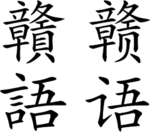This article needs additional citations for verification. (November 2013) |
| Gan | |||||||||||||||||||||
|---|---|---|---|---|---|---|---|---|---|---|---|---|---|---|---|---|---|---|---|---|---|
| Gann | |||||||||||||||||||||
| 贛語/赣语 Gon ua | |||||||||||||||||||||
 Gan ua (Gan) written in Chinese characters | |||||||||||||||||||||
| Native to | China | ||||||||||||||||||||
| Region | central and northern Jiangxi, eastern Hunan, eastern Hubei, southern Anhui, northwest Fujian | ||||||||||||||||||||
| Ethnicity | Gan people | ||||||||||||||||||||
Native speakers | 23 million (2021)[1] | ||||||||||||||||||||
Early forms | |||||||||||||||||||||
| Varieties | |||||||||||||||||||||
| Chinese character Pha̍k-oa-chhi | |||||||||||||||||||||
| Language codes | |||||||||||||||||||||
| ISO 639-3 | gan | ||||||||||||||||||||
| Glottolog | ganc1239 | ||||||||||||||||||||
| Linguasphere | 79-AAA-f | ||||||||||||||||||||
 | |||||||||||||||||||||
| Chinese name | |||||||||||||||||||||
| Traditional Chinese | 贛語 | ||||||||||||||||||||
| Simplified Chinese | 赣语 | ||||||||||||||||||||
| Gan | Gon ua | ||||||||||||||||||||
| |||||||||||||||||||||
| Jiangxi dialect | |||||||||||||||||||||
| Traditional Chinese | 江西話 | ||||||||||||||||||||
| Simplified Chinese | 江西话 | ||||||||||||||||||||
| Gan | Kongsi ua | ||||||||||||||||||||
| |||||||||||||||||||||
Preview warning: Page using Template:Infobox language with unknown parameter "dialect_label"
Gan, Gann[2] or Kan is a group of Sinitic languages spoken natively by many people in the Jiangxi province of China, as well as significant populations in surrounding regions such as Hunan, Hubei, Anhui, and Fujian. Gan is a member of the Sinitic languages of the Sino-Tibetan language family, and Hakka is the closest Chinese variety to Gan in terms of phonetics.
There are different dialects of Gan; the Nanchang dialect is the prestige dialect.
- ^ Gan Chinese at Ethnologue (26th ed., 2023)

- ^ The double nn represents the falling tone in Mandarin